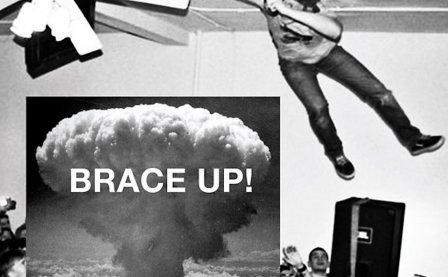Massachusetts-cum-UK percussionist and improviser Chris Corsano uses the solo medium as one where he can knit together a number of short, to-the-point, yet exploratory vignettes that both serve as language refinement and exist as concise works all their own. Cut is the third solo disc on his Hot Cars Warp Records (indeed) imprint, following the excellent The Young Cricketer (reissued by Family Vineyard in 2008) and a keyboard-voice outing titled Blood Pressure. Corsano is known, rightly, for his collaborative work with saxophonist Paul Flaherty, but more recently, he’s worked as part of the Chikamorachi rhythm section (with bassist Darin Gray) and lent deep and telepathic support to storied Japanese reedman Akira Sakata. Corsano’s collaborative list is pretty lengthy, and it’s in that context that his solo work is quite singular.
Over 19 tracks, Corsano rarely edges over the five-minute mark (one piece on Cut is nearly seven minutes, but the rest are brief) in approaching drums, metal objects, saxophone parts, gongs, cymbals, and woodblocks with sticks, bows, and breath. Although he’s constructed his language with very specific and personal intentions, I’m reminded of the liner notes that Swiss percussionist Pierre Favre added to his 1969 Drum Conversation LP (Calig): “This record is a musical portrait of myself. It expresses my mood on the day I made the recording… This record is not a test, nor a brilliant showpiece. It is simply a conversation that I should like to have with you.” Of course, the conversation is not only with the listener, but implicitly with the instrument; alongside Favre, Milford Graves, Tatsuya Nakatani, Masahiko Togashi, and others, Corsano seeks to expand his work as a “drummer” or even “percussionist” into a broader “instrumentalist.” Graves and Favre are the only above-mentioned musicians who come out of the jazz tradition at its most basic. While Corsano isn’t a “jazz” player per se, his work certainly stands alongside musicians like these. The music in some ways ceases to be about the drums as we normally think of them, instead being a personally expressive vehicle that can mass rhythms or present a variety of singing and scraping tones. With a recording that moves between a variety of palettes as Cut does, there is a danger of it becoming a clinical exploration, but it’s here that Corsano remains deftly attuned to emotion and curiosity.
The opening “Twice Removed” begins with a cymbal invocation, quickly shifting into a relentless piling of toms with spiderwebbed gong and metal accents, the whole thing headed toward a quilted and flitting abstraction by the end of its four minutes. “Shank and Spindle” is a brusque, droning piece involving string drum, violin bow, melodica, and bells, which seems drawn from the Theater of Eternal Music or C. Spencer Yeh (a frequent partner). But to create such a hot and ultimately present mass of sound from minimal means and short working time is truly a testament to Corsano’s economy and inventiveness. “Scalpels” is a narrow and piercing etude for bowed metal and saxophone mouthpiece, and isolates the canvas of group improvisation into one individual statement, abbreviated by a highly resonant and polyrhythmic metal rack workout titled “The Attendant.” The latter, one of a number of linking fragments, abruptly transitions into a sweaty, damped, and athletic traps and woodblock composition, “Famously Short Arms” (dig the Albini-esque titles).
“These Things Are Not Fancy” is the lengthiest piece here and finds Corsano on stringed drum and two bows, reaching transcendent harmonic interplay on what is literally a metal string across a floor tom (rather than a psalterium). Moving between percussive clatter and cymbal splash on “Two Leyaks and a Minister,” Corsano tightens his language on metal frame and gongs, which could validate such work alongside vibraphone and lamellaphone masters; he then moves to triangle, woodblock, and scraped drum heads for the jittery “Not Now Not Later Not Ever.” Applying sticks to the stringed drum on “Fed Ex’d Gorilla,” he approximates a hyper-minimalist and almost maddening monochord dulcimer, while “My Face, Spited” involves a disassembled C-melody saxophone, funnels, and a floor tom to stomach-churning result.
With 19 tracks covering a variety of approaches and linked by short improvisations, Cut is a cohesive and workmanlike record with minimal flair and a lot of interest. In continuous dialogue with his own ideas and limitations, as well as that of his large but well-chosen arsenal, Chris Corsano continues to display a solo language that is both rigorous and inviting.
More about: Chris Corsano




